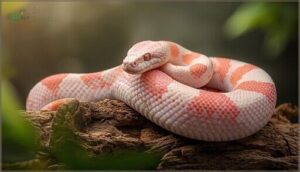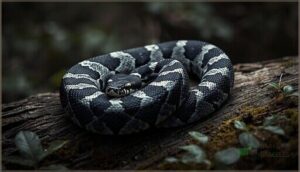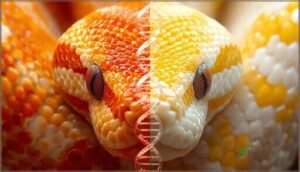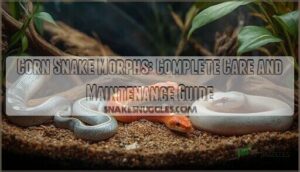This site is supported by our readers. We may earn a commission, at no cost to you, if you purchase through links.
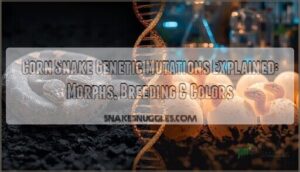
You might breed two seemingly identical corn snakes and end up with offspring that look nothing like their parents—bright orange hatchlings from gray adults, or pure white babies from vividly colored pairs. This genetic sleight of hand isn’t magic; it’s the predictable result of inherited mutations that reshape pigment production and pattern formation at the cellular level.
Understanding corn snake genetic mutations explained through Mendelian inheritance reveals how specific gene variants—amelanistic, anerythristic, hypomelanistic—interact to produce over a hundred distinct morphs. When you grasp which traits are dominant, recessive, or codominant, breeding transforms from guesswork into calculated outcomes, letting you predict exactly which colors and patterns will emerge in your clutch.
Table Of Contents
Key Takeaways
- Corn snake color and pattern variations result from predictable Mendelian inheritance patterns involving specific gene mutations like amelanistic (removes black pigment), anerythristic (eliminates red/yellow), and hypomelanistic (reduces melanin), with recessive traits requiring two copies to express visually.
- Pattern morphs like Motley and Stripe stem from mutations in the CLCN2 gene that alter chloride channel function in pigment cells, while combining multiple mutations creates compound morphs such as Snow (amelanistic + anerythristic) among over 800 documented varieties.
- Punnett squares and dihybrid crosses transform breeding from guesswork into calculated predictions, with heterozygous pairings of recessive genes producing 25% visual morphs, 50% hidden carriers, and 25% normal offspring per standard Mendelian ratios.
- Ethical breeding requires maintaining genetic diversity through outcrossing unrelated individuals and detailed record-keeping to prevent inbreeding complications, health defects, and fertility issues while balancing aesthetic goals with long-term population welfare.
Corn Snake Genetics Basics
You can’t breed corn snakes effectively without understanding how their genes work. Every color and pattern you see is the result of specific genetic instructions passed from parent to offspring.
Let’s break down the fundamental principles that determine what traits your snakes will express and pass along to the following generation.
Genes and Inheritance Patterns
Your corn snake’s appearance isn’t random—it’s a genetic lottery determined by inheritance patterns. Each snake inherits one allele from each parent at every gene locus, creating combinations that dictate trait inheritance through predictable Mendelian ratios. Dominant genes express with just one copy, while recessive genes need two.
Your corn snake’s appearance is a genetic lottery where inherited alleles follow predictable Mendelian patterns to determine every visible trait
Understanding these molecular genetics principles through Punnett Squares and gene expression patterns unlocks the secret to genetic mapping and breeding success. The genetics of corn snakes can be further understood by studying genetic color inheritance patterns.
Dominant, Recessive, and Codominant Genes
Gene expression follows three distinct patterns in trait inheritance. Dominant genes show up with just one copy—like Tessera’s altered patterns—while recessive genes need two copies to express, requiring homozygous pairing. That’s why amelanistic and anerythristic morphs only appear when both parents pass the mutation.
Codominant genes blend both alleles equally, creating unique genetic variance you’ll spot immediately in heterozygous offspring.
The study of genetic mutations, such as the LYST gene mutation, helps researchers understand the intricacies of color pattern formation.
Understanding Alleles in Corn Snakes
You’ve learned how genes express themselves—now let’s look at what alleles actually do at the molecular level. Alleles are different versions of the same gene, and their combinations drive every morph you see.
Here’s how allele expression shapes corn snake genetics:
- Each parent contributes one allele per gene locus
- Homozygous pairs (two identical alleles) guarantee trait expression
- Heterozygous combinations create genetic variation through dominant or recessive interactions
- Punnett squares predict offspring outcomes by mapping allele inheritance
- Chromatophore function depends on which alleles regulate pigment cell distribution
Molecular genetics reveals that mutations at specific gene locations—like the CLCN2 gene affecting motley and stripe patterns—alter how your snake looks without changing behavior. Gene mapping studies have pinpointed exact chromosomal intervals where these alleles sit, explaining why amelanistic and ultra genes can’t both express fully—they’re allelic, occupying the same locus.
Understanding genetic terminology makes breeding predictable. When you cross a wild-type snake with a snow morph, you’re combining dominant genes (normal pigmentation) with recessive genes (amelanistic and anerythristic alleles). The offspring appear normal but carry hidden recessive alleles, ready to produce visual morphs in future generations.
Common Corn Snake Genetic Mutations
Understanding the most common genetic mutations in corn snakes unlocks the secret to their stunning variety. Each mutation alters specific pigments or patterns, creating the foundation for hundreds of distinct morphs you’ll encounter in breeding and collection.
Let’s examine the four key mutations that have shaped the corn snake hobby and continue to drive innovation in morph development.
Amelanistic (Albino) Mutation
Imagine a corn snake stripped of all black pigment—that’s what amelanistic (albino) morphs look like. You’ll notice their white or pale pink base with vibrant red and orange patterns where black borders once existed.
This recessive mutation disrupts melanin production through an OCA2 gene variant, giving these snakes distinctive pink eyes and making them one of the most popular color genetics morphs in captive breeding.
Anerythristic Mutation
You’ve seen the opposite of amelanistic—anerythristic mutations eliminate red, yellow, and orange pigments entirely. These recessive traits produce monochromatic patterns dominated by black, gray, and brown scales, earning them the nickname “black albino.”
Anerythristic genetics follow strict Mendelian inheritance, requiring two copies for color absence to manifest. When you cross anerythristic with amelanistic morphs, you’ll create the striking Snow morph through codominant genetic expression.
Hypomelanistic and Snow Morphs
Hypomelanistic morphs reduce melanin production while keeping dark eyes—unlike amelanistic variants with their signature red gaze. You’ll notice brighter colors and gray belly checkers instead of true black.
Snow corn snake morphs combine amelanistic and anerythristic genes in a double recessive pairing, producing pale white-to-yellow snakes with pink eyes. Breeding outcome predictions require understanding both parents carry copies of each recessive allele for visual expression.
Motley, Stripe, and Zipper Patterns
Pattern genetics in corn snakes centers on the CLCN2 gene, where mutations drive distinct morph characteristics. Stripe formation results from a transposon disrupting chloride channel function, creating continuous longitudinal lines. Motley expression shows dominant inheritance with reduced CLCN2 activity, fusing dorsal blotches into broken patterns.
Zipper mutations produce wavy, misaligned markings through selective breeding—illustrating how color and pattern genetics shape snake patterns beyond simple color inheritance in corn snake morphs.
How Genetic Mutations Affect Appearance
When a genetic mutation flips the switch on pigment production or pattern formation, you’ll see the results immediately in your corn snake’s appearance. These changes aren’t random—each mutation targets specific genes that control color intensity, pigment distribution, or the arrangement of scales and markings.
Let’s break down how these genetic shifts translate into the stunning visual variations you see in different morphs.
Color Variations and Pigment Changes
You’ll notice corn snake color morphs arise from mutations targeting specific pigment cells called chromatophores. Amelanistic mutations knock out melanin entirely, revealing vibrant reds and oranges, while anerythristic variants eliminate red and yellow pigments, leaving gray tones.
These genetic expression changes in chromatophore biology demonstrate how single-gene alterations in pigment genetics drive the stunning color morphing you see across different morphs.
Pattern Differences Explained
You’ll find that pattern genetics in corn snakes centers on a single gene, CLCN2, which controls snake morphology through ion channel function in pigment cells.
The Motley morph shows fused dorsal blotches creating a linear design, while Stripe features continuous longitudinal color patterns.
Both pattern morphs eliminate the checkered belly seen in wild-type corn snake morphs, demonstrating how genetic coding drives distinct phenotype expression and pattern variations.
Morph Combinations and Hybrid Morphs
When you stack multiple mutations, compound morphs like Snow (amelanistic + anerythristic) or Ghost (hypomelanistic + anerythristic) emerge through dihybrid crosses. Hybrid breeding introduces external genetics—Jungle corns blend kingsnake traits, while Creamsicles mix Great Plains rat snake genes.
Gene expression becomes a genetic lottery with over 800 documented corn snake morphs possible. Pattern genetics and morph inheritance create nearly limitless morph combinations through careful selective breeding.
Genetics in Corn Snake Breeding
You don’t need guesswork when breeding corn snakes—genetic tools let you predict exactly what traits your hatchlings will inherit. Punnett squares and dihybrid crosses turn breeding from chance into calculated outcomes, helping you plan for specific morphs before the first egg hatches.
But successful breeding isn’t just about genetics on paper; it’s also about maintaining healthy, diverse bloodlines that protect the long-term vitality of your collection.
Predicting Offspring Traits With Punnett Squares
You can decipher the genetic lottery in corn snake breeding by mastering Punnett Squares—a simple grid that maps trait inheritance with surprising accuracy. These breeding strategies let you forecast gene expression before your eggs even hatch, turning educated guesses into calculated predictions.
- Het × het pairings for recessive genes yield 25% visible morphs, 50% hidden carriers, and 25% normal offspring per egg
- Dominant traits like tessera appear in 50% of offspring when paired with normal snakes—no mystery hets hiding
- Codominant genes create visible blends in heterozygous snakes, changing your inheritance patterns entirely
- Online Punnett analysis tools automate the math, calculating genetic probability across complex multi-gene crosses instantly
Dihybrid Crosses in Practice
You’ll step beyond single-trait Punnett squares when cross breeding for two independent traits simultaneously. Dihybrid crosses reveal how color inheritance plays out across multiple genes—think amelanistic and anerythristic combined. Your breeding outcomes follow predictable ratios: cross two double-hets and you’ll see roughly 9:3:3:1 phenotypes emerge, including the stunning snow morph when both recessive genes align.
These genetic predictions transform guesswork into calculated morph variations you can bank on.
| Parent Genotypes | Hybrid Offspring Ratio | Morph Variations |
|---|---|---|
| AaBb × AaBb | 9:3:3:1 | Wildtype, Amelanistic, Anerythristic, Snow |
| AABb × aabb | 100% AaBb | All Wildtype (het both) |
| Aabb × aaBb | 1:1:1:1 | Equal distribution across four phenotypes |
Ethical Breeding and Genetic Diversity
Breeding ethics isn’t just about producing eye-catching morphs—it’s about safeguarding your snakes’ long-term health and genetic variation. Responsible breeding maintains sturdy populations while avoiding the pitfalls of excessive inbreeding.
Your breeding guide should prioritize:
- Detailed record-keeping to track inheritance patterns and guide pairing decisions
- Regular outcrossing with unrelated individuals to prevent genetic bottlenecks
- Monitoring offspring health to catch recessive disorders early
- Balancing aesthetics with welfare in your color genetics program
- Supporting species conservation through diversity management practices
Studies show that managed genetic diversity reduces congenital defects markedly—your snakes deserve that standard.
Rare and Notable Corn Snake Morphs
Some corn snake morphs stand out not just for their beauty, but for the rare genetic events that created them. Mutations like lavender and palmetto showcase the cutting edge of reptile genetics, where science meets art in living color.
Let’s explore these remarkable morphs, their origins, and what you need to know about their health and care.
Lavender and Palmetto Mutations
Among the rarest corn snake morphs, Lavender stands out for its distinctive gray-on-pink coloration—caused by a recessive LYST gene mutation affecting pigment organelle development.
Palmetto traits, by contrast, follow incompletely dominant color inheritance: heterozygous snakes show reduced black pigmentation, while homozygous individuals display nearly white, patternless bodies.
Understanding this genetic variance helps you predict morph breeding outcomes with precision.
Designer Morphs and Their Origins
Designer corn snakes trace their genetic heritage to early breeders in the 1980s who combined wild strains with targeted breeding techniques. The Butter morph, for instance, blends amelanistic and caramel mutations—creating stunning cream color variations.
French breeders introduced the Creamsicle by crossing amelanistic specimens with Emory’s ratsnakes. Today’s pattern development and morph creation continue refining these color morphs, expanding possibilities for snake enthusiasts worldwide.
Health Considerations of Genetic Mutations
Genetic variation shapes both beauty and wellness in your corn snakes. While most morphs thrive with proper care, understanding mutation impacts helps you make informed choices.
Key morph health risks to monitor:
- Palmetto morphs may show ocular abnormalities like “bug eyes,” though most individuals remain healthy
- Amelanistic and anerythristic lines require outcrossing to prevent reduced genetic diversity
- CLCN2 mutations (Motley, Stripe) pose no documented neurological concerns
- Inbred designer morphs risk fertility complications without proper genetic management
- Breeding ethics demand prioritizing snake welfare over appearance alone
Responsible genetic practices guarantee your collection’s longevity.
Frequently Asked Questions (FAQs)
How do corn snake genetics compare to other reptile species?
You’ll notice corn snakes stand out: they display over 800 morphs compared to slower-evolving reptiles, thanks to higher mutation rates and remarkable breeding population size enabling remarkable genetic variation across reptile genetics and herpetology.
What role do transposons play in corn snake mutations?
Transposable elements act as genomic architects, inserting themselves into critical genes like CLCN2 and OCA
These insertions disrupt chloride channels and pigment regulation, creating stripe patterns, amelanism, and other phenotype changes that drive mutation rates.
Conclusion
What begins as random variation in a single gene becomes a canvas for deliberate design once you decode the rules. With corn snake genetic mutations explained through inheritance patterns, you’re no longer gambling on color—you’re engineering it.
Each breeding pairing becomes a calculated experiment, turning recessive carriers into visible phenotypes and hidden genotypes into predictable outcomes. Master these genetic principles, and your breeding projects shift from hopeful surprise to intentional artistry, one precisely planned clutch at a time.

